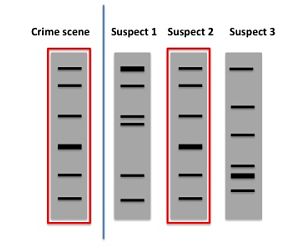The Scene of the Crime
The body of a woman is found behind an abandoned warehouse on the outskirts of town. Forensic experts carry out a technical examination of the scene and suggest strangulation as the cause of death. The absence of bloody footprints or weapons means there are no obvious leads to the killer. The experts carefully dust down the body and its surroundings for fingerprints, hairs and clothing fibres, possibly containing skin and bodily fluids. This material is taken back to the lab and thoroughly examined and Bingo! Skin and hair particles found under the victim’s fingernails probably belong to the killer, indicating that a struggle took place. If the experts can isolate DNA from these skin and hair particles, they can attempt to identify the killer using PCR and genetic fingerprinting, providing the first solid lead towards solving this crime.
So Where Does PCR Come into All of This?
In criminal investigations, the amount of DNA available for analysis is limited to whatever can be isolated from a few strands of hair, skin cells, blood or other bodily fluids left behind at the scene. It can be tedious to isolate sufficient amounts of intact DNA from such material, thus impeding the application of modern DNA technologies to identify perpetrators and ultimately solve crimes. PCR represents a fast, cost-effective, and relatively easy solution to this problem, in that it can rapidly amplify specific sequences from the isolated DNA, increasing the amount of material and paving the way for further analysis.
PCR is therefore a prerequisite to many modern DNA technologies and is an essential component of genetic fingerprinting. Genetic fingerprinting is based on distinguishing individuals according to differences in their genetic material. This is possible because while humans share 99.9 % of their DNA with each other, they differ by 0.1 %. DNA fingerprinting stems from the groundbreaking work of British geneticist Alec Jeffreys, who in 1985 published a method whereby DNA probes could be used to detect short repetitive regions in the human genome that were highly variable. He termed these regions hypervariable microsatellites, and found that the exact number of repeats was unique from one individual to the next with the exception of identical twins (1). The advent of PCR technology around the same time allowed further development of Jeffreys’ technique since PCR permits analysis of very small amounts of DNA, even from old or partially degraded samples.
In modern genetic fingerprinting, these repetitive sequences are referred to as variable number tandem repeats (VNTRs). Genomic regions containing these repeats are very similar between closely related individuals, but different enough so that unrelated individuals are highly unlikely to have the same VNTRs.
How Is DNA Fingerprinting Actually Carried Out?
Today, the most commonly used genetic fingerprinting method uses a particular class of VNTRs known as short tandem repeats (STRs). This method takes advantage of highly polymorphic regions that have short repeated sequences, most often containing 3-5 repeated bases. Because unrelated people will almost definitely differ in their number of repeats, STRs can be used to confidently discriminate between unrelated persons.

DNA is isolated from material collected at the crime scene. The STR loci are amplified by PCR using sequence-specific primers. These primers are designed in such a way that they can amplify the STR loci from any individual. The resulting DNA fragments are then processed using electrophoresis. Separation and detection of these fragments results in a unique pattern of bands, often referred to as a genetic fingerprint, and it is this unique pattern that is ultimately used in criminal investigations to match suspect DNA with DNA found at the scene.
A genetic fingerprint can be directly used to match DNA found at a crime scene with suspect DNA to ultimately secure a criminal conviction. As with traditional fingerprinting, genetic fingerprinting requires the presence of a corresponding fingerprint from any suspect under consideration in order to make an exact match. In other words, DNA collected at a crime scene has to match actual suspect DNA that is already on file at the detective bureau, or a DNA sample can be taken as required if other evidence connected to the crime scene points towards a particular individual.
As well as using genetic fingerprinting to convict criminals, this technique also serves as a powerful tool to prove the innocence of suspects and previous wrongly convicted individuals. Alongside traditional fingerprint analysis, DNA fingerprinting is among the most unambiguous methods of identifying suspects today. PCR has therefore revolutionised forensic science and criminal investigations, and in combination with traditional detective work, it will continue to be a powerful investigative tool in the future.
Additional Reading:
1. Jeffreys AJ, Wilson V, Thein SL. Hypervariable ‘minisatellite’ regions in human DNA. Nature. 1985;314(6006):67-73.







